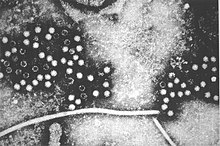Orthohepevirus A
| Orthohepevirus A | |
|---|---|

| |
| TEM micrograph of Orthohepevirus A virions | |
| Virus classification | |
| (unranked): | Virus |
| Realm: | Riboviria |
| Kingdom: | Orthornavirae |
| Phylum: | Kitrinoviricota |
| Class: | Alsuviricetes |
| Order: | Hepelivirales |
| Family: | Hepeviridae |
| Genus: | Orthohepevirus |
| Species: | Orthohepevirus A
|
| Synonyms[1] | |
| |
The hepatitis E virus (HEV) is the causative agent of hepatitis E. It is of the species Orthohepevirus A.[a][2][1]
Globally, approximately 939 million corresponding to 1 in 8 individuals have ever experienced HEV infection. About 15–110 million individuals have recent or ongoing HEV infection.[3] The virus particle was first seen in 1983,[4] but was only molecularly cloned in 1989.[5]
Genome and proteome
Orthohepevirus A can be classified into eight different genotypes from different geographical regions: genotype 1 (Asia), genotype 2 (Africa and Mexico), genotype 3 (Europe and North America), genotype 4 (Asia); genotypes 5 and 6 have been detected in Asian wild boar and genotypes 7 and 8 in camels.[2][6]
The viral genome is a single strand of positive-sense RNA that is about 7200 bases in length. The three open reading frames (ORF1, ORF2 and ORF3) encode for three proteins (O1, O2, O3), two of which are polyproteins, that is, they are cleaved into fragments which carry out the actual functions of the virus (see figure). The O1 protein consists of seven such fragments, namely Met (methyltransferase), Y (Y-domain), Plp (papain-like protease), V (proline-rich variable region), X (X-domain, macro-domain), Hel (helicase), and Rdrp (RNA-dependent RNA polymerase). The Pvx domain is a fusion protein consisting of the Plp, V, and X domains. The O3 protein is encoded by a single open-reading frame (ORF3). The O2 protein encodes the capsid, which is composed of three domains, namely the shell domain (S) and two protruding domains (P1, P2).[7] Numbers in the figure indicate positions in the RNA sequence.
Interactome
The protein-protein interactome among Orthohepevirus A proteins has been mapped by Osterman et al. (2015), who found 25 interactions among the 10 proteins studied. Almost all (24) of these interactions were considered as of "high quality".[8]
Structure
The viral particles are 27 to 34
Taxonomy
It was previously classified in the family Caliciviridae. However, its genome more closely resembles rubella virus. It is now classified as a member of the genus Orthohepevirus in the family Hepeviridae.[2]
Evolution
The strains of HEV that exist today may have arisen from a shared ancestor virus 536 to 1344 years ago.
Whereas genotype 2 remains less commonly detected than other genotypes, genetic evolutionary analyses suggest that genotypes 1, 3, and 4 have spread substantially during the past 100 years.[12]
See also
Notes
References
- ^ a b c Purdy, Michael A.; et al. (June 2014). "New Classification Scheme for Hepeviridae" (PDF). International Committee on Taxonomy of Viruses (ICTV). Retrieved 1 May 2019.
The species Hepatitis E virus will be renamed Orthohepevirus A, and the species Avian hepatitis E virus will be renamed Orthohepevirus B.
- ^ a b c d "Hepeviridae - Hepeviridae - Positive-sense RNA Viruses - ICTV". www.ictv.global.
- PMID 32281721.
- ^ PMID 6409836.
- PMID 2107574.
- ^ Schlauder, G. G. & Mushahwar, I. K. (2001) Genetic heterogeneity of hepatitis E virus. J Med Virol 65, 282–92
- PMID 21345356.
- PMID 26463011.
- PMID 21203540.
- PMID 31664890.
- PMID 27264728.)
{{cite journal}}: CS1 maint: multiple names: authors list (link - ^ Izopet J, Abravanel F, Dalton H, Nassim RK (2014) Hepatitis E Virus Infection. Clin Micro Reviews 27 (1) 116–138

